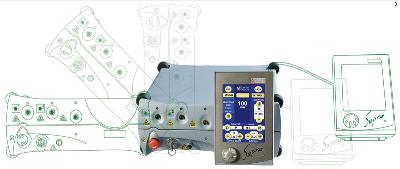Laser delivery system for sight threatening retinal diseases in children
Project location: Italy, Rome
Project start date: August 2010 -
Project end date: August 2010
Project number: 2010-13
Beneficiary: Fondazione PTV Policlinico Tor Vergata
 The Nando Peretti Foundation has awarded a grant to purchase the Laser machine so that the hospital team will be able to reduce both time of LASER sessions and ocular pain in children who need to be treated in order to avoid sight threatening retinal complications.
The Nando Peretti Foundation has awarded a grant to purchase the Laser machine so that the hospital team will be able to reduce both time of LASER sessions and ocular pain in children who need to be treated in order to avoid sight threatening retinal complications.Furthermore, other pediatric ophthalmologists will know about the new available LASER very helpful in dealing with younger patients. Fondazione PTV is the University Hospital of Università di Roma Tor Vergata.
The Retinal Diseases Unit is "Centro di Riferimento Regionale per la Diagnosi e Cura Degenerazione Maculare Senile e Patologie Retiniche Cecitanti" (Regional Reference Center for Diagnosis and Treatment of Senile Macular Degeneration and sight threatening retinal diseases).
In Italy incidence of type 1 diabetes mellitus is 7 per 100.000 children between 0 and 15 years of age. In some regions, like Sardinia, the number rises up to 30 per 100.000.
One of the most important complications of diabetes is diabetic retinopathy that can occur even after one or two years of disease onset. Diabetic Retinopathy occurs in a more or less severe form in nearly half of diabetic patients.
Diabetic retinopathy is the alteration of the permeability of the blood vessels of the retina that occurs when high blood glucose, the hallmark of diabetes, has damaged the small vessels that provide oxygen and nutrients to the retina. It consists on the formation of lesions such aneurysms, hemorrhages and exudates spread all over the retina. These retinal anatomical changes can lead to severe visual impairment and even blindness due to retinal detachment, vitreous hemorrhages and neovascular glaucoma. To avoid these ocular complications, the retina is usually treated with LASER photocoagulation in order to stop the pathologic process. Laser therapy is the standard of care. It consists on applying, in different sessions, more than a thousand of LASER burns over the entire retina while sparing the central macular area. The number of the sessions varies based on pain that patients feel during treatment. The treatment of one eye takes usually 3 to 4 sessions, up to 30 minutes each. LASER therapy in young patients and particularly in children is a more challenging procedure due to lower threshold of pain compare to older patients.
The Medical Retina Unit of Policlinico di Tor Vergata is the consultant of the Pediatric Diabetology Service of the same Hospital. Proff.ssa Maria Luisa Manca Bitti is the director of the service. This service takes care of about 400 young diabetic patients, between 2 and 18 years of age, who are periodically sent to our Retina Unit for complete eye examination.
When diabetic retinopathy has a moderate or severe stage it requires further examinations and more accurate tests such fluorescein angiography (an angiogram is obtained by photographing the fluorescence of the retina after injection of a particular dye into the systemic circulation). This exam will help to decide either to treat the retina with LASER or not.
When LASER treatment is indicated, an appointment is usually scheduled in a short time unless it is urgent. In this case child will start the first LASER session the same day of the fluorescein angiography.
With the standard LASER, where every single burn has to be delivered separately one by one because the system produces a single laser spot on a single foot switch depression, each session may last around 20 minutes to treat half retina, depending on the surgeon's skill. At the end of treatment 1200 to 1600 LASER burns are needed to treat the entire peripheral retina.
With the new LASER up to 36 laser spots can be delivered by a single foot pedal depression. The surgeon can select one of the several adjustable predetermined patterns, shapes, and sizes, including lines, squares, and circular arcs. It allows faster sessions of 5 minutes to treat the same amount of retina. Furthermore the treatment is smoother and with homogeneous distribution of the laser burns, reducing patient discomfort.
In fact, reduced pulse duration compared to standard LASER, is associated with less pain because of decreased thermal diffusion into the choroid, a layer underneath the retina, which is rich in sensory nerves.
Thanks to this quick and painless treatment patients are more easily treated especially when they are very young.
Same kind of LASER treatment is indicated in other retinal diseases that occur in children. They are rare congenital conditions that if not promptly treated can cause severe visual loss and blindness. Coats' disease is one of them. It is usually unilateral and affects young boys. If diagnosis is made in the first stage of the disease the laser treatment can have good chance of success.




